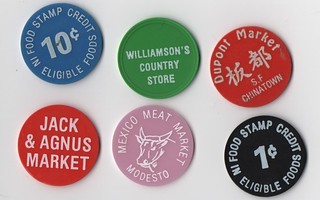
PREV ARTICLE
NEXT ARTICLE
FULL ISSUE
PREV FULL ISSUE
FOOD STAMP CHANGE TOKEN RESEARCH UPDATERegarding his call for assistance cataloging U.S. Food stamp Change Tokens, Scott Hopkins writes: Here are the folks who responded to my call and lent a hand:
I may have missed someone. But these are the ones who I replied to and answered back, starting a conversation of sorts. Leon Saryan writes: In Bruce Smith's excellent notes about food stamp tokens, he states that the paper food stamp coupons of the 1960s to 1990a were "probably" printed at the BEP. I did not think there was any uncertainty on this point. Can you clarify? I contacted Neil Shafer about this point. He writes: Bruce Smith last week did an excellent job of presenting the overall picture of food stamps. There are just a few items that I would like to clarify. Food stamps were all uniface, from the stamp images of the 1930s to the end in 2009, regardless of design. The Bureau of Engraving did all the printing until 1971, then American Bank Note was given contracts for portions of the production. All Food Stamp Coupons and Food Coupons were illegal for collectors to hold until late June of 2009. The 1961 issue of 25c red and $1.00 black Food Stamp Coupons were issued on an experimental basis to a small number of counties considered to be low-income areas. In 1964 the orange 50c and blue $2 were introduced as the Program got underway big time. In 1970 the $5 was introduced. Change for 49c or less was required until March 1975 when the 1, $5 and $10 coupons came out. Then the change requirement went to 99c or less as the $1 could be used as change. A firm in WI called Tropical Lab and Manufacturing Company based I believe in La Crosse was responsible for large thin plastic tokens Bruce referred to. BEP printed the original food stamps and also the Food Stamp Coupons issued 1961-62. BEP also printed all the Food Coupons without date, then those dated 1967 at first without and later with serial numbers. There were two experimental printings on the Giori press; these were $2 dated 1967-G and $5 coupons dated 1970-G. Both are extremely rare; Amon Carter had the only one I ever saw in a collection; I think it was the $2. BEP printed 1971-dated Food Coupons as follows: 50c only for high value books, also $2 and $5 for regular consumption as well as the high value books. These higher face value books, introduced early in 1972, were called "household" books; they had special combinations of different denominations in the same book. There were three groups of four such booklets, with face values raised twice as allotments were changed. The first group had face values of $32, $60, $88 and $108; serial prefixes F, G, H, J respectively. Group II had face values of $36, $64, $92 and $112; serial prefixes K, L. M. N respectively. This group was in use from July 1972 to July 1973. Group III had face values of $38, $66, $94 and $116; serial prefixes P, Q, R, S respectively. Group III was phased out in March 1975 when the new designs and denominations were introduced. All coupons from any high value books re extremely scarce to very rare. American Bank note printings begin with Food Coupons dated 1971A; these were the first made outside the BEP, even though they carry the BEP logo at bottom. Those dated 1973 were also ABN products, and these omit the BEP logo. Great project. Thanks, everyone. I also put Scott in touch with Neil Shafer. -Editor
To read the earlier E-Sylum articles, see: FOOD STAMP CHANGE TOKEN INFORMATION SOUGH (www.coinbooks.org/esylum_v18n04a06.html) THE HISTORY OF FOOD STAMP CHANGE TOKENS (www.coinbooks.org/esylum_v18n05a11.html) Wayne Homren, Editor The Numismatic Bibliomania Society is a non-profit organization promoting numismatic literature. See our web site at coinbooks.org. To submit items for publication in The E-Sylum, write to the Editor at this address: whomren@gmail.com To subscribe go to: https://my.binhost.com/lists/listinfo/esylum All Rights Reserved. NBS Home Page Contact the NBS webmaster 
|
